Current Differential Protection for Active Distribution Networks Based on Adaptive Phase Angle Compensation Coefficient
Abstract
:1. Introduction
- The traditional overcurrent protection based on local information is improved to apply to active distribution networks with complex fault characteristics. In [7,8,9,10], the protective setting value of the overcurrent relay is modified adaptively according to the behavior of DGs during faults, which improves the sensitivity of traditional overcurrent protection and has a good economy. However, the topology of the active distribution network is complex, and there are still problems with protection delay and coordination difficulty between feeder sections after high permeability DGs access. In addition, directional overcurrent relays can adapt to the power flow changes caused by DG access to the distribution network [11,12]. However, there are still defects in the case of high DG penetration;
- To solve the problem of protection based on local information, the pilot differential protection using adjacent information is introduced into the active distribution network. Pilot differential protection can be divided into impedance and current differential protection. Some scholars use high-frequency impedance [13], positive-sequence impedance [14], and integrated impedance [15] to construct differential protection that has good selectivity. In [16], the fault is identified according to the phase difference between the bus voltage’s positive-sequence fault component and the feeder current’s positive-sequence fault component. However, this method is only applicable to the grid-connected microgrid. All of the above-mentioned methods require voltage measurement. However, voltage transformers are rarely installed in low- and medium-voltage distribution networks. In [17,18], the current differential protection (CDP) with restraint characteristics is constructed using the positive-sequence current fault component (PSCFC), which effectively solves the weak feeding problem of the active distribution network. However, the protection sensitivity is reduced or even refuses to trip in the case of high resistance faults or those containing the unmeasurable load branch (ULB). Reference [19] proposed a CDP method based on sequence components, which overcomes the problem of the low sensitivity of traditional differential protection by introducing a differential coefficient but does not consider the influence of the ULB. In [20], the longitudinal protection is constructed using the amplitude and phase characteristics of the PSCFC on both sides of the line during internal and external faults. It has an adaptive braking threshold, but it requires strict data synchronization. Although the CDP proposed in [17,18,19,20,21,22] improves the selectivity of protection, it is still restricted by one or more of the following factors: (1) high fault resistance will reduce the sensitivity of protection; (2) the ULB will affect the reliability of protection; (3) high data synchronization requirements; and (4) DG random output will lead to protection misjudging. It is necessary to propose a complete CDP scheme to address the shortcomings in the above research;
- Since it is difficult to fully adapt to complex fault situations in the distribution network using only local information, centralized protection schemes using network-wide information have been proposed [23,24,25,26]. The distribution terminals upload the multi-point measurement information, and the master station uses the multi-point measurement information to identify the fault. Due to its dependence on the master station for decision-making, the centralized protection scheme will fail when the communication or master station fails, which limits the application of this method in the existing distribution network.
2. Amplitude and Phase Characteristics of PSCFCs in Active Distribution Networks
2.1. Amplitude and Phase Characteristics of PSCFCs in Active Distribution Networks with SBDGs
2.2. Amplitude and Phase Characteristics of PSCFCs in Active Distribution Networks with IBDGs
2.2.1. Amplitude Characteristics of PSCFCs
2.2.2. Phase Characteristics of PSCFCs
3. Current Differential Protection Based on Adaptive Angle Compensation Coefficient
3.1. Action Characteristics of Traditional Current Differential Protection
- Using the PSCFC to construct protection can effectively eliminate the influence of load currents, reflect all fault types, and solve the weak-infeed problem of active distribution network protection;
- Data transmission is significantly reduced compared to the traditional split-phase CDP. In the distribution network, three-phase reclosing is mainly used, and it is not necessary to judge the fault type. Therefore, the advantage of using a positive-sequence component to construct protection is more prominent.
- The downstream feeder of the fault point contains SBDG. When a fault occurs inside the protected feeder, the phase difference of the PSCFCs on both sides is slight, and the TCDP can trip correctly;
- The downstream feeder of the fault point contains IBDG. When a fault occurs inside the protected feeder, the phase difference of the PSCFCs on both sides has an extensive range, and the maximum value can reach nearly 180°. In the limit case, the amplitude ratio ε on both sides of the feeder is 1.6, and the corresponding λ is 0.63. In the process of the fault approaching the limit state, the sensitivity of the TCDP gradually decreases, and finally, it cannot trip correctly. If a specific fault scenario falls within the light red zone in Figure 5, the TCDP will refuse to trip. By reducing the restraint coefficient K, the sensitivity of the TCDP action in case of an in-zone fault can be improved, and the tripping area of the TCDP is expanded simultaneously. However, if the value of K is too small, it may lead to the misjudging of TCDP in cases of external faults, and the reliability is reduced.
3.2. Principle of Current Differential Protection Based on Adaptive Phase Angle Compensation Coefficient
- For non–fault sections, considering the measurement error of the CT, the lock angle of the CDP, and a certain margin, it can be considered that the amplitude ratio of PSCFCs is ε∈[0.8,1.25], and the phase difference of PSCFCs is δ∈[135°,225°]. When taking the limit case ε = 1.25, δ = 135°, the proposed protection is not compensated, the restraint current is still greater than the differential current, and the protection does not trip reliably;
- For the fault section with SBDGs connected downstream of the fault point, it is known from Section 2 that the phase angle difference δ of the PSCFCs on both sides is small. At this time, regardless of the value of ε, the protection can trip sensitively;
- For the fault section with IBDGs connected downstream of the fault point, the amplitude ratio of the PSCFCs on both sides of the protected feeder is greater than 1.5. In this case, the measured current ∆İn is compensated so that the phase of ∆İn after compensation equals the phase of ∆İm. After compensation, the points falling into the light red area in Figure 5 are moved to the phase angle difference 0° axis of the tripping area. The protection can trip reliably and with high sensitivity.
4. Influence of Unmeasurable Load Branches on Protection and Countermeasures
4.1. Influence of Unmeasurable Load Branches on Protection
4.1.1. Faults Occur inside Protected Feeder and Fault Point Is Located Downstream of ULB
4.1.2. Faults Occur Inside Protected Feeder and Fault Point Is Located Upstream of ULB
4.1.3. Faults Occur outside a Protected Feeder and Fault Point Is Located Downstream of ULB
4.1.4. Faults Occur outside Protected Feeder and Fault Point out of Operation during Faults Test Is Located Upstream of ULB
4.2. Principle of the Auxiliary Criterion
5. Influence of Date Synchronization Errors on Protection
5.1. Error Analysis of Fault Date Self-Synchronization Algorithm
5.2. Analysis of ACDP Anti-Synchronization Error
6. Simulation and Analysis
6.1. Simulation Model
6.2. Analysis of Simulation Results
6.2.1. Metallic Multi-phase Faults Test
6.2.2. High Fault Resistance Test
6.2.3. Unmeasured Load Branch Test
6.2.4. Time Synchronization Errors Test
6.2.5. DG out of Operation during Faults Test
7. Conclusions
- In the case of different types of DG access, when various types of multi-phase faults occur, the proposed ACDP can trip correctly, and the sensitivity is higher than that of the TCDP;
- The proposed ACDP has a strong ability to withstand fault resistance and can still trip sensitively under 150Ω fault resistance, while TCDP cannot trip correctly under 100 Ω fault resistance;
- The proposed protection scheme can effectively deal with the negative impact of unmeasured load branches and has high reliability;
- Without strict time synchronization, the proposed ACDP can still trip sensitively when the time synchronization error is 4.6 ms;
- The proposed ACDP is not affected by DG random output and has high reliability.
Author Contributions
Funding
Institutional Review Board Statement
Informed Consent Statement
Data Availability Statement
Conflicts of Interest
Nomenclature
| ACDP | Adaptive Current Differential Protection |
| CT | Current Transformer |
| CDP | Current Differential Protection |
| DG | Distributed Generation |
| FDSS | Fault Data Self-Synchronization |
| FFT | Fast Fourier Transform |
| IBDG | Inverter-Based Distributed Generation |
| LVRT | Low Voltage Ride-Through |
| PSCFC | Positive–sequence Current Fault Component |
| SBDG | Synchronous-Based Distributed Generation |
| TCDP | Traditional Current Differential Protection |
| ULB | Unmeasurable Load Branch |
Appendix A
References
- Barani, M.; Aghaei, J.; Akbari, M.A.; Niknam, T.; Farahmand, H.; Korpas, M. Optimal Partitioning of Smart Distribution Systems into Supply-Sufficient Microgrids. IEEE Trans. Smart Grid 2019, 10, 2523–2533. [Google Scholar] [CrossRef]
- Telukunta, V.; Pradhan, J.; Agrawal, A.; Singh, M.; Srivani, S.G. Protection Challenges Under Bulk Penetration of Renewable Energy Resources in Power Systems: A Review. CSEE J. Power Energy Syst. 2017, 3, 365–379. [Google Scholar] [CrossRef]
- Hooshyar, A.; Iravani, R. Microgrid Protection. Proc. IEEE 2017, 105, 1332–1353. [Google Scholar] [CrossRef]
- Jamali, S.; Borhani-Bahabadi, H. Protection Method for Radial Distribution Systems with DG Using Local Voltage Measurements. IEEE Trans. Power Del. 2019, 34, 651–660. [Google Scholar] [CrossRef]
- Liu, J.; Zhang, X.; Tong, X.; Zhang, Z.; Du, H.; Chen, Y. Fault Location for Distribution Systems with Distributed Generations. Autom. Electr. Power Syst. 2013, 37, 36–42+48. [Google Scholar]
- Castillo-Calzadilla, T.; Cuesta, M.A.; Quesada, C.; Olivares-Rodriguez, C.; Macarulla, A.M.; Legarda, J.; Borges, C.E. Is a massive deployment of renewable-based low voltage direct current microgrids feasible? Converters, protections, controllers, and social approach. Energy Rep. 2022, 8, 12302–12326. [Google Scholar] [CrossRef]
- Coffele, F.; Booth, C.; Dysko, A. An Adaptive Overcurrent Protection Scheme for Distribution Networks. IEEE Trans. Power Del. 2015, 30, 561–568. [Google Scholar] [CrossRef] [Green Version]
- Kumar, D.S.; Srinivasan, D.; Reindl, T. A Fast and Scalable Protection Scheme for Distribution Networks with Distributed Generation. IEEE Trans. Power Del. 2016, 31, 67–75. [Google Scholar] [CrossRef]
- Shen, S.; Lin, D.; Wang, H.; Hu, P.; Jiang, K.; Lin, D.; He, B. An Adaptive Protection Scheme for Distribution Systems with DGs Based on Optimized Thevenin Equivalent Parameters Estimation. IEEE Trans. Power Del. 2017, 32, 411–419. [Google Scholar] [CrossRef]
- Aghdam, T.S.; Karegar, H.K.; Zeineldin, H.H. Optimal Coordination of Double-Inverse Overcurrent Relays for Stable Operation of DGs. IEEE Trans. Ind. Informat. 2019, 15, 183–192. [Google Scholar] [CrossRef]
- Hooshyar, A.; Iravani, R. A New Directional Element for Microgrid Protection. IEEE Trans. Smart Grid 2018, 9, 6862–6876. [Google Scholar] [CrossRef]
- Sharaf, H.M.; Zeineldin, H.H.; El-Saadany, E. Protection Coordination for Microgrids with Grid-Connected and Islanded Capabilities Using Communication Assisted Dual Setting Directional Overcurrent Relays. IEEE Trans. Smart Grid 2018, 9, 143–151. [Google Scholar] [CrossRef]
- Jia, K.; Bi, T.; Ren, Z.; Thomas, D.W.P.; Sumner, M. High Frequency Impedance Based Fault Location in Distribution System with DGs. IEEE Trans. Smart Grid 2018, 9, 807–816. [Google Scholar] [CrossRef]
- Chen, G.; Liu, Y.; Yang, Q. Impedance Differential Protection for Active Distribution Network. IEEE Trans. Power Del. 2020, 35, 25–36. [Google Scholar] [CrossRef]
- Sharma, N.K.; Samantaray, S.R. PMU Assisted Integrated Impedance Angle-Based Microgrid Protection Scheme. IEEE Trans. Power Del. 2020, 35, 183–193. [Google Scholar] [CrossRef]
- Zhang, F.; Mu, L. A Fault Detection Method of Microgrids with Grid-Connected Inverter Interfaced Distributed Generators Based on the PQ Control Strategy. IEEE Trans. Smart Grid 2019, 10, 4816–4826. [Google Scholar] [CrossRef]
- Gao, H.; Li, J.; Xu, B. Principle and Implementation of Current Differential Protection in Distribution Networks with High Penetration of DGs. IEEE Trans. Power Del. 2017, 32, 565–574. [Google Scholar] [CrossRef]
- Zhou, C.; Zou, G.; Du, X.; Zang, L. Adaptive current differential protection for active distribution network considering time synchronization error. Int. J. Electr. Power Energy Syst. 2022, 140, 108085. [Google Scholar] [CrossRef]
- Chen, S.; Tai, N.; Fan, C.; Liu, J.; Hong, S. Sequence-component-based current differential protection for transmission lines connected with IIGs. IET Gener. Transmiss. Distrib. 2018, 12, 3086–3096. [Google Scholar] [CrossRef]
- Zhou, C.; Zou, G.; Du, X.; Yang, J. A Pilot Protection Method Based on Positive Sequence Fault Component Current for Active Distribution Networks. Proc. CSEE 2020, 40, 2102–2112. [Google Scholar]
- Nikolaidis, V.C.; Michaloudis, G.; Tsimtsios, A.M.; Tzelepis, D.; Booth, C.D. A Coordinated Multi-Element Current Differential Protection Scheme for Active Distribution Systems. IEEE Trans. Power Del. 2022, 37, 4261–4271. [Google Scholar] [CrossRef]
- Adewole, A.C.; Rajapakse, A.D.; Ouellette, D.; Forsyth, P. Protection of active distribution networks incorporating microgrids with multi-technology distributed energy resources. Electr. Power Syst. Res. 2022, 202, 107575. [Google Scholar] [CrossRef]
- Elbana, M.S.; Abbasy, N.; Meghed, A.; Shaker, N. µPMU-based smart adaptive protection scheme for microgrids. J. Modern Power Syst. Clean Energy 2019, 7, 887–898. [Google Scholar] [CrossRef] [Green Version]
- Ghotbi-Maleki, M.; Chabanloo, R.M.; Zeineldin, H.H.; Miangafsheh, S.M.H. Design of Setting Group-Based Overcurrent Protection Scheme for Active Distribution Networks Using MILP. IEEE Trans. Smart Grid 2021, 12, 1185–1193. [Google Scholar] [CrossRef]
- Mirshekali, H.; Dashti, R.; Keshavarz, A.; Torabi, A.J.; Shaker, H.R. A Novel Fault Location Methodology for Smart Distribution Networks. IEEE Trans. Smart Grid 2021, 12, 1277–1288. [Google Scholar] [CrossRef]
- Gutierrez-Rojas, D.; Nardelli, P.H.J.; Mendes, G.; Popovski, P. Review of the State of the Art on Adaptive Protection for Microgrids Based on Communications. IEEE Trans. Ind. Informat. 2021, 17, 1539–1552. [Google Scholar] [CrossRef]
- Chen, H.; Xu, S.; Li, Z.; Jin, Z.; Wan, X.; Hou, W.; Wu, J.; Xiong, M. A new fast comprehensive protection scheme of an active distribution network considering the abnormal operating conditions of 5G communication. Power Syst. Prot. Control. 2021, 49, 159–168. [Google Scholar]
- Xu, B.; Li, T.; Xue, Y. Relaying Protection and Automation of Distribution Networks, 1st ed.; China Electric Power Press: Beijing, China, 2017; pp. 206–212. [Google Scholar]
- Ghanaatian, M.; Lotfifard, S. Sparsity-Based Short-Circuit Analysis of Power Distribution Systems with Inverter Interfaced Distributed Generators. IEEE Trans. Power Syst. 2019, 34, 4857–4868. [Google Scholar] [CrossRef]
- Li, J.; Gao, H.; Zhu, G. Inverse-Time Current Differential Protection in Active Distribution Network Considering Characteristics of Inverter-Interfaced Distributed Generations. Trans. China Electrotech. Soc. 2016, 31, 74–83. [Google Scholar]
- China National Standard GB/T 19964-2012; Technical Requirements for Connecting Photovoltaic Power Station to Power System. Standardization Administration of China: Beijing, China, 2012.
- He, J.; Li, Y.; Dong, X. Principles of Relay Protection of Electric Power System, 4th ed.; China Electric Power Press: Beijing, China, 2010; pp. 140–142. [Google Scholar]
- Ge, Y.Z. Principles and Technologies of New Relay Protection and Fault Location, 2nd ed.; Xi’an Jiaotong University Press: Xi’an, China, 2007; pp. 1–14. [Google Scholar]
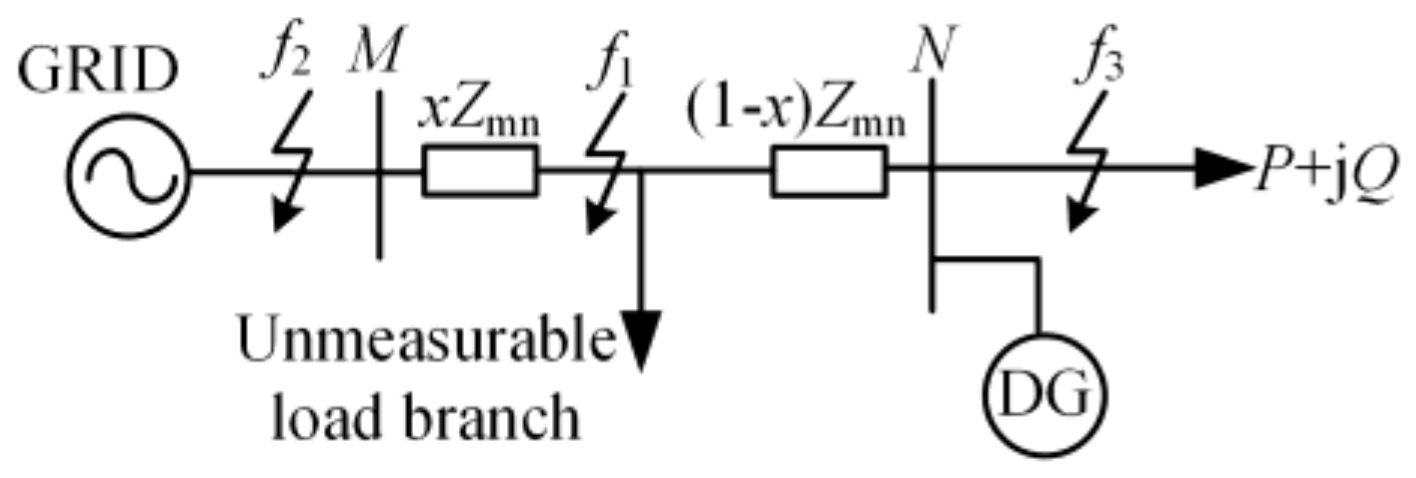
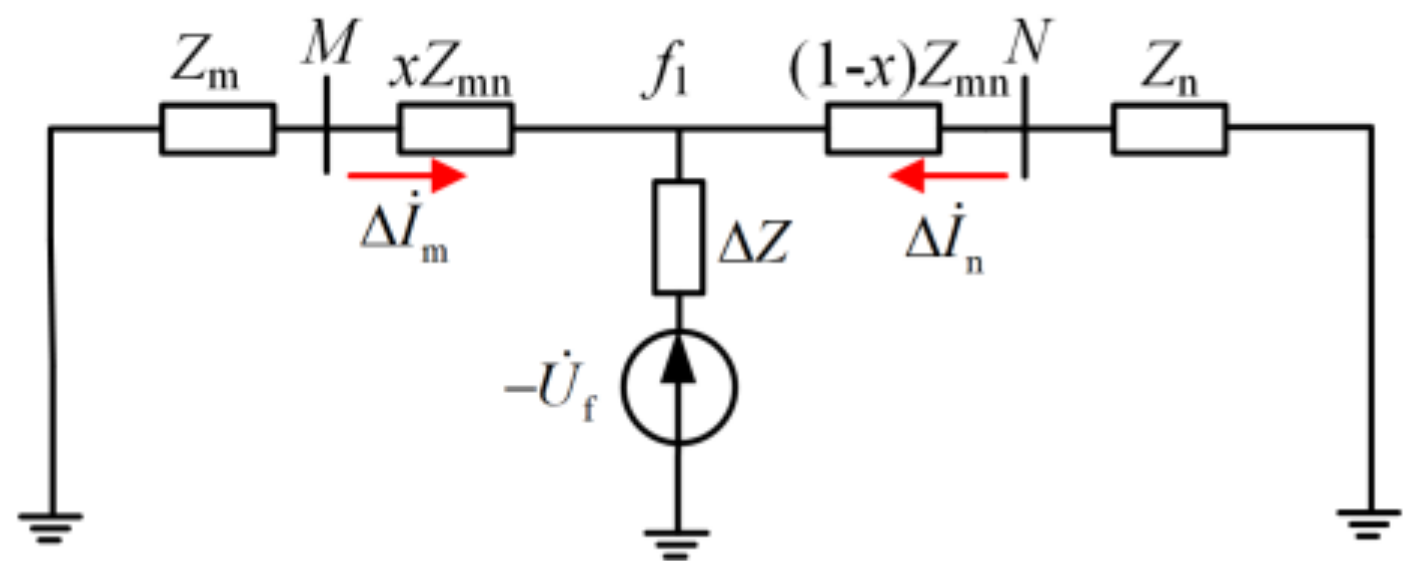
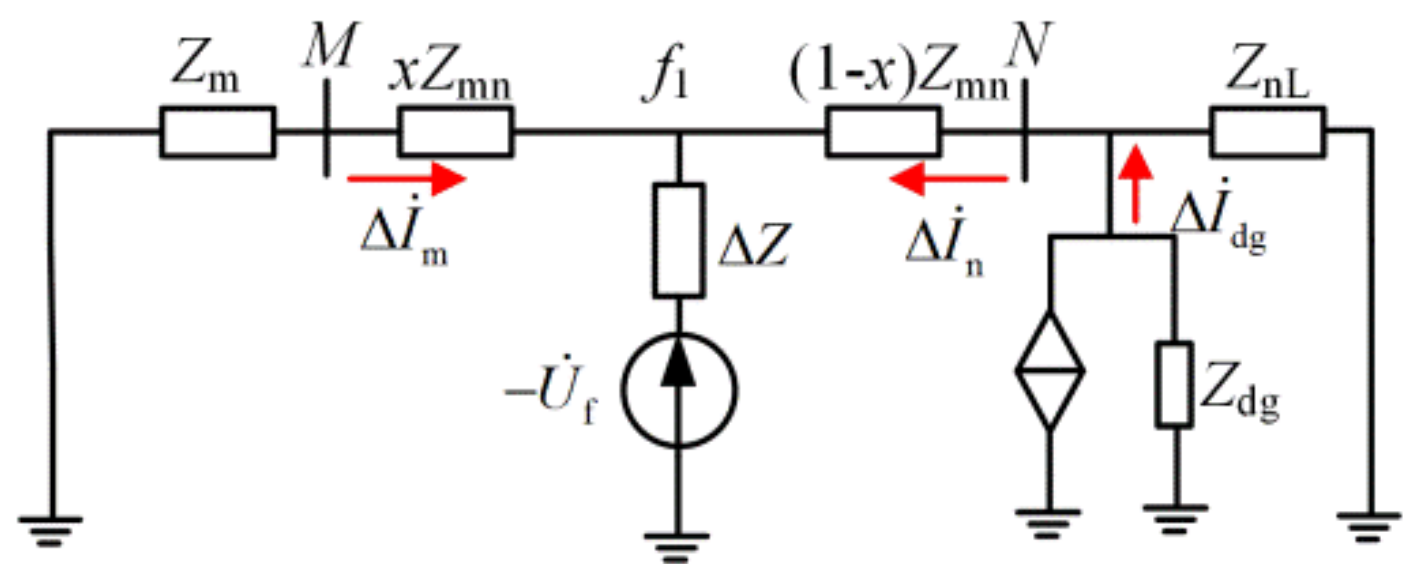
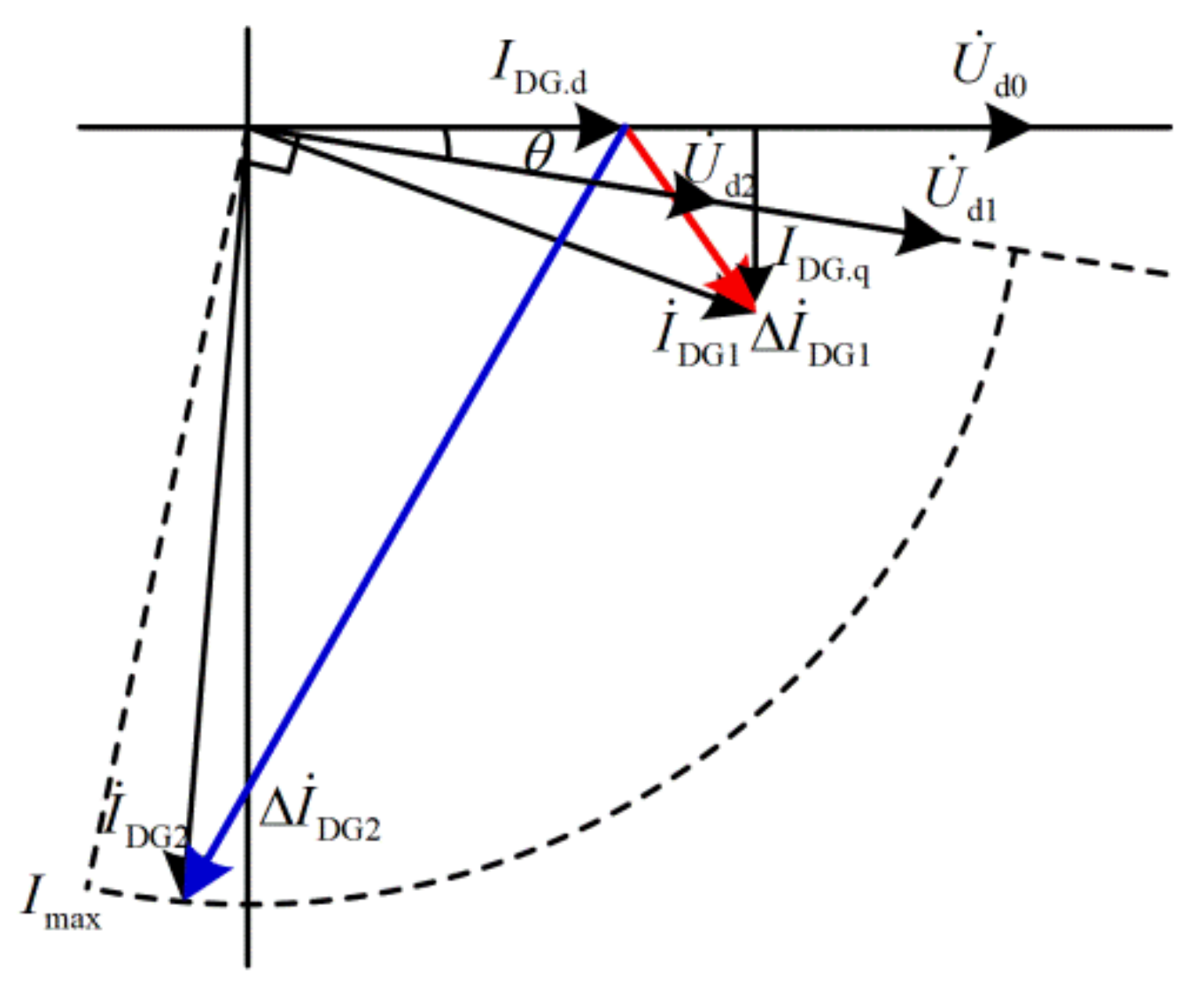
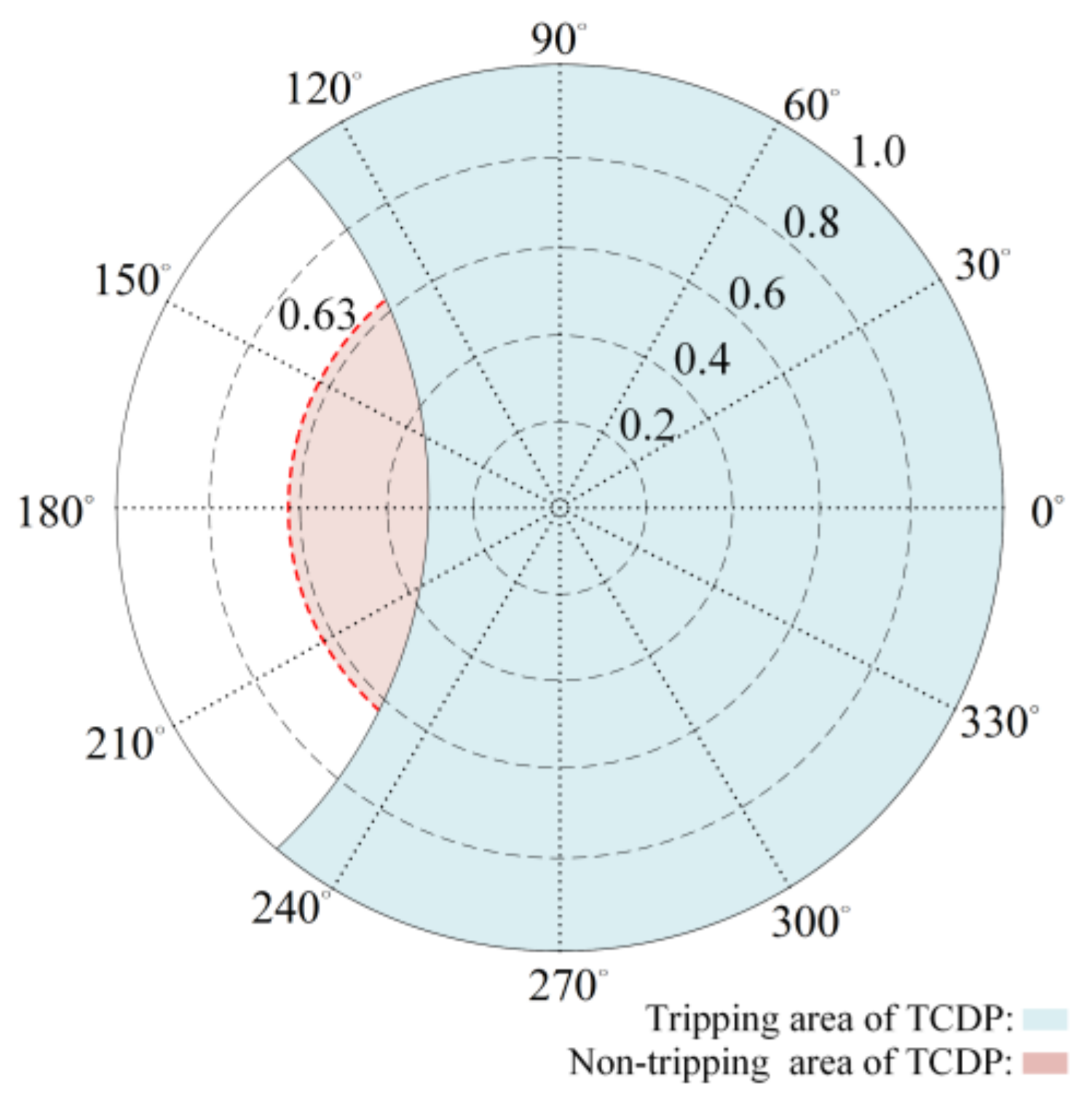
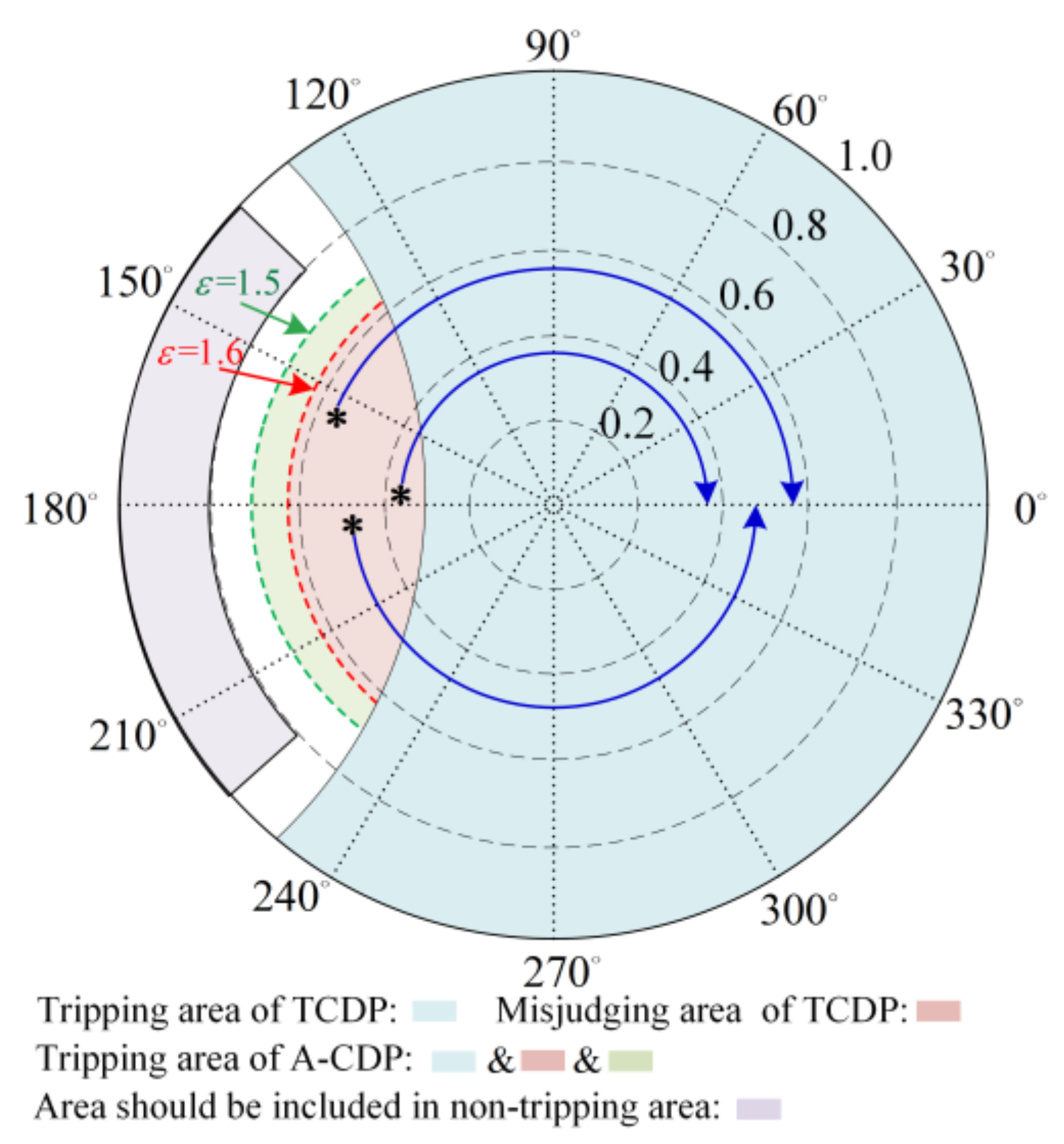

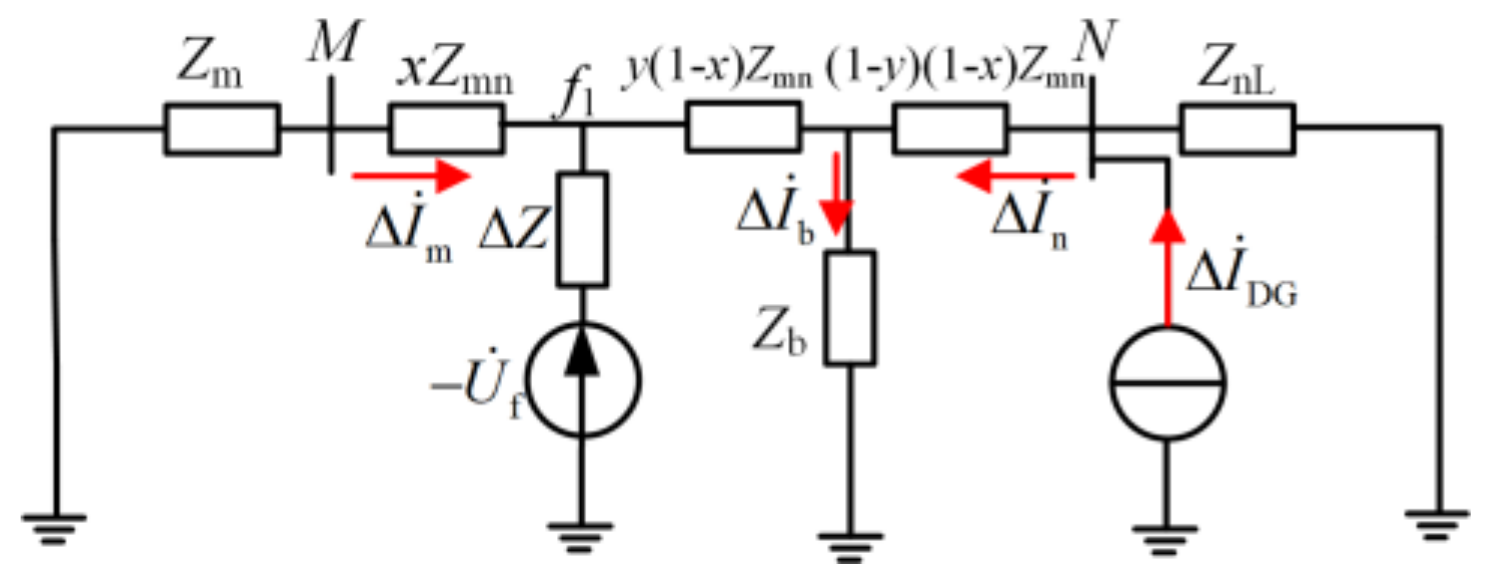
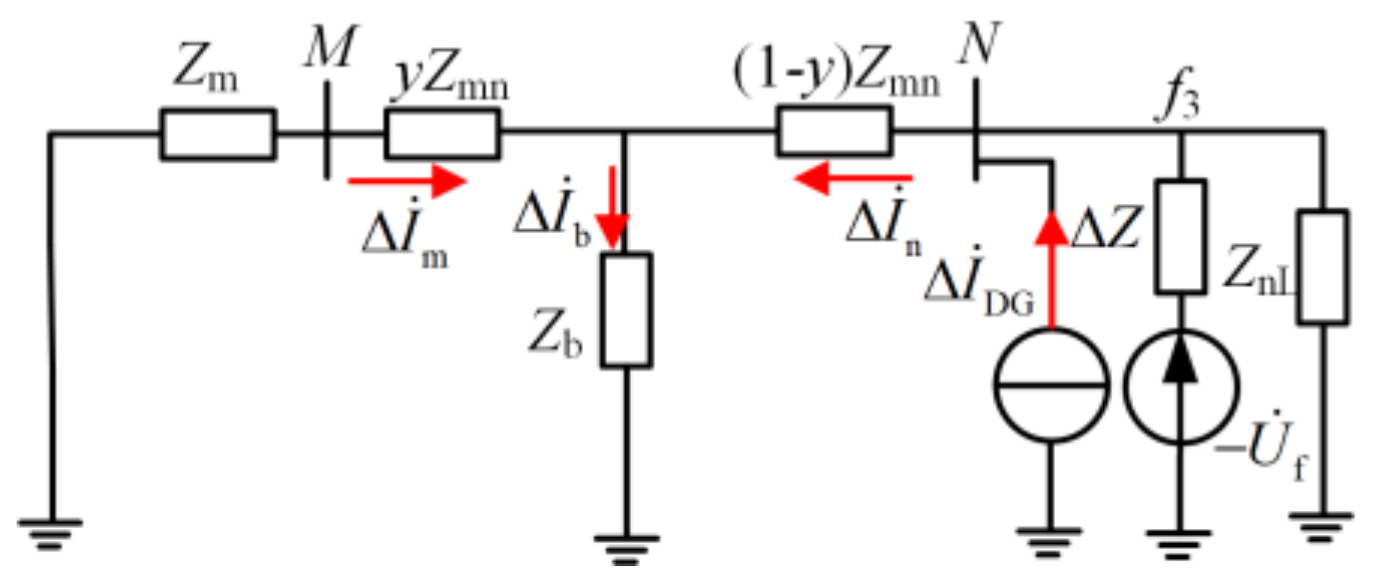
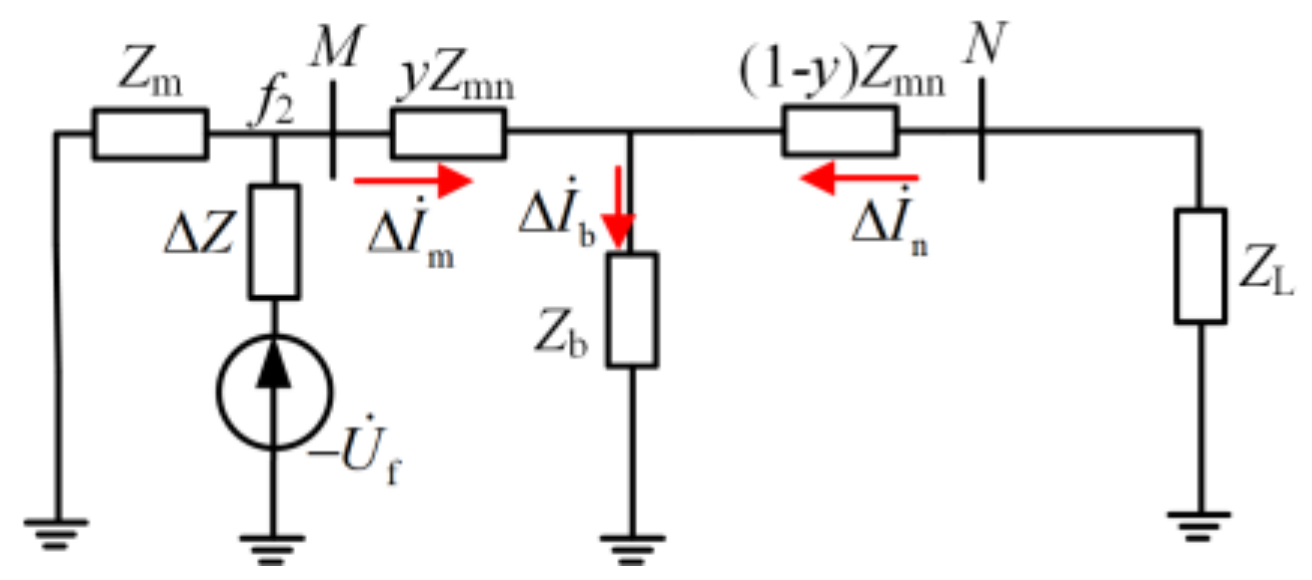


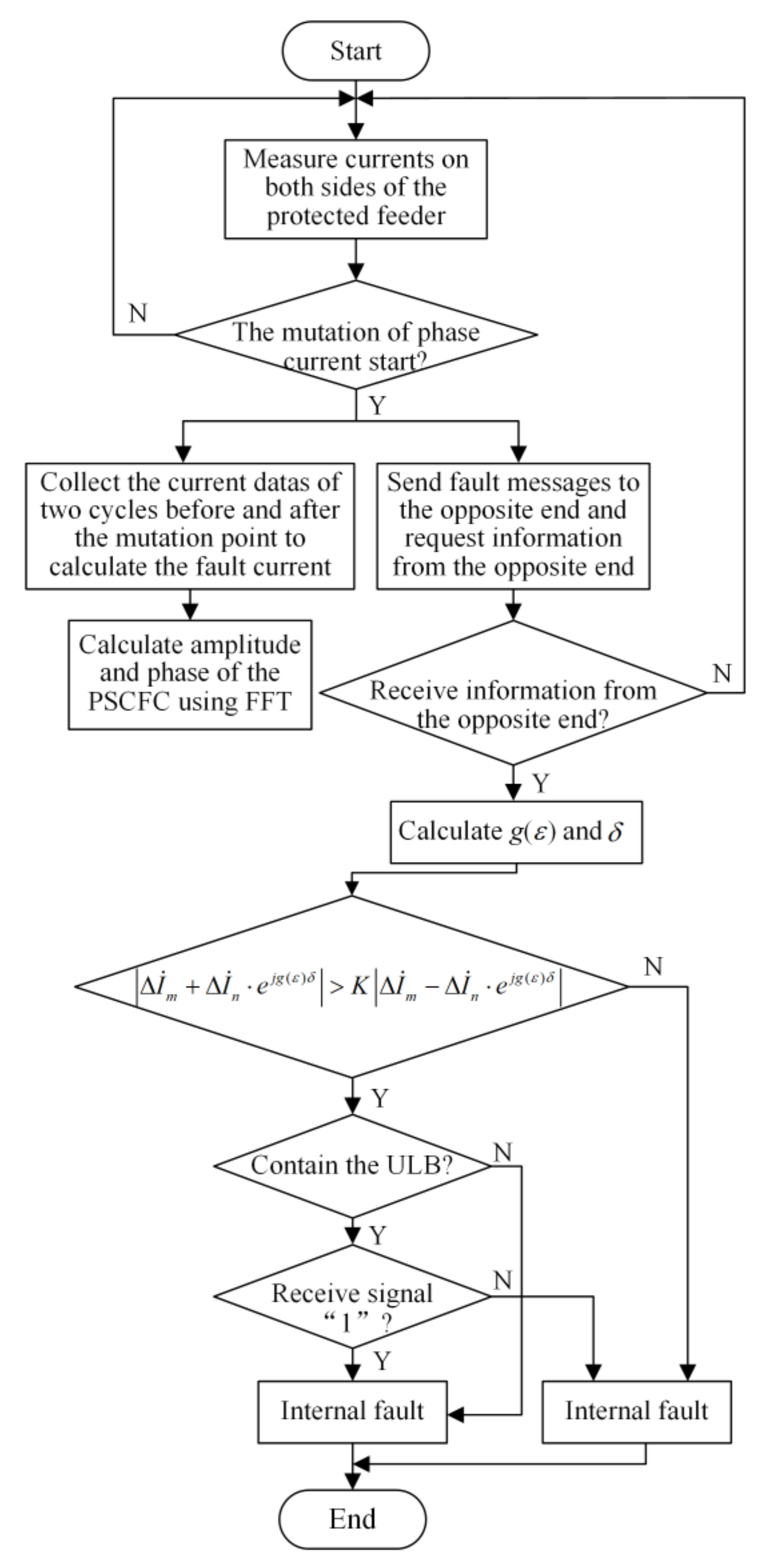



| Parameters | Values | Parameters | Values |
|---|---|---|---|
| Rated voltage | 10 kV | Capacity of DG4 | 4 MW |
| Capacity of grid | 50 MW | Capacity of L7 | (1.2 + j0.6) MVA |
| Capacity of DG1 | 2 MW | Capacity of other loads | (0.6 + j0.3) MVA |
| Capacity of DG2, DG3 | 2.5 MW |
| Parameters | Values | Parameters | Values |
|---|---|---|---|
| positive-sequence impedance | (0.13 + j0.402) Ω/km | Length of feeder section B5B6 | 5 km |
| Zero-sequence impedance | (0.26 + j0.87) Ω/km | Length of the other feeder sections | 4 km |
| Length of feeder sections B1B4 and B4B5 | 6 km |
| Fault Type | Fault Location | ε | δ/(rad) | Ksen | Trip or Not | ||
|---|---|---|---|---|---|---|---|
| ACDP | TCDP | ACDP | TCDP | ||||
| AB | 5% | 5.10 | −0.77 | 2.13 | 1.89 | Yes | Yes |
| 50% | 3.34 | −0.63 | 2.65 | 2.30 | Yes | Yes | |
| 95% | 2.21 | −0.46 | 3.79 | 3.23 | Yes | Yes | |
| ABG | 5% | 5.45 | −0.65 | 2.07 | 1.91 | Yes | Yes |
| 50% | 3.36 | −0.48 | 2.64 | 2.42 | Yes | Yes | |
| 95% | 2.18 | −0.25 | 3.85 | 3.64 | Yes | Yes | |
| ABC | 5% | 5.02 | 0.16 | 2.14 | 2.13 | Yes | Yes |
| 50% | 2.82 | −5.75 | 3.00 | 2.63 | Yes | Yes | |
| 95% | 2.00 | −5.60 | 4.29 | 2.97 | Yes | Yes | |
| Fault Type | Fault Location | ε | δ/(rad) | Ksen | Trip or Not | ||
|---|---|---|---|---|---|---|---|
| ACDP | TCDP | ACDP | TCDP | ||||
| AB | 5% | 2.21 | 0.21 | 3.79 | 3.65 | Yes | Yes |
| 50% | 1.23 | 0.22 | 9.33 | 9.33 | Yes | Yes | |
| 95% | 0.73 | 0.21 | 7.68 | 7.68 | Yes | Yes | |
| ABG | 5% | 2.22 | 0.22 | 3.77 | 3.63 | Yes | Yes |
| 50% | 1.20 | 0.24 | 9.44 | 9.44 | Yes | Yes | |
| 95% | 0.72 | 0.23 | 7.18 | 7.18 | Yes | Yes | |
| ABC | 5% | 2.26 | 0.25 | 3.70 | 3.53 | Yes | Yes |
| 50% | 1.25 | 0.23 | 8.89 | 8.89 | Yes | Yes | |
| 95% | 0.72 | 0.21 | 7.40 | 7.40 | Yes | Yes | |
| Fault Resistance | Fault Location | ε | δ/(rad) | Ksen | Trip or Not | ||
|---|---|---|---|---|---|---|---|
| ACDP | TCDP | ACDP | TCDP | ||||
| 25 Ω | 5% | 6.16 | 1.36 | 1.98 | 1.53 | Yes | Yes |
| 50% | 5.53 | 1.43 | 2.06 | 1.50 | Yes | Yes | |
| 95% | 2.89 | −4.37 | 2.94 | 1.16 | Yes | Yes | |
| 50 Ω | 5% | 9.61 | −4.44 | 1.76 | 1.35 | Yes | Yes |
| 50% | 4.07 | 1.48 | 2.36 | 1.49 | Yes | Yes | |
| 95% | 1.85 | 1.73 | 4.79 | 1.25 | Yes | Yes | |
| 100 Ω | 5% | 5.97 | −1.96 | 2.00 | 1.26 | Yes | Yes |
| 50% | 4.57 | −3.84 | 2.23 | 1.02 | Yes | Yes | |
| 95% | 2.47 | −3.67 | 3.37 | 0.71 | Yes | NO | |
| 150 Ω | 5% | 6.00 | −4.11 | 2.00 | 1.19 | Yes | Yes |
| 50% | 3.28 | −3.84 | 2.68 | 0.90 | Yes | NO | |
| 95% | 7.28 | −3.91 | 1.88 | 1.17 | Yes | Yes | |
| Fault Type | Fault Point | Fault Location | ε | δ/(rad) | Ksen | Zact | Trip or Not |
|---|---|---|---|---|---|---|---|
| AB | f1 | 5% | 4.53 | −0.92 | 2.24 | 0.14 | Yes |
| 50% | 2.35 | −0.63 | 2.04 | 1.19 | Yes | ||
| 95% | 2.26 | −0.28 | 3.70 | 0.47 | Yes | ||
| f2 | 5% | 0.86 | −3.20 | 0.12 | −0.27 | NO | |
| 50% | 0.86 | −3.20 | 0.12 | −1.40 | NO | ||
| 95% | 0.89 | −3.19 | 0.09 | −2.49 | NO | ||
| f3 | 5% | 1.60 | 2.94 | 6.19 | −2.50 | NO | |
| 50% | 1.56 | 2.99 | 6.53 | −1.62 | NO | ||
| 95% | 1.52 | 3.07 | 6.92 | −0.15 | NO | ||
| ABg | f1 | 5% | 4.22 | −0.73 | 2.32 | 0.15 | Yes |
| 50% | 2.78 | −0.27 | 3.03 | 1.21 | Yes | ||
| 95% | 2.28 | −0.13 | 2.56 | 0.47 | Yes | ||
| f2 | 5% | 0.87 | −3.22 | 0.08 | −0.27 | NO | |
| 50% | 0.88 | −3.20 | 0.10 | −1.42 | NO | ||
| 95% | 0.88 | −3.20 | 0.10 | −2.29 | NO | ||
| f3 | 5% | 1.49 | 2.97 | 0.29 | −2.09 | NO | |
| 50% | 1.50 | 3.00 | 0.29 | −1.46 | NO | ||
| 95% | 1.43 | 3.11 | 0.24 | −0.29 | NO | ||
| ABC | f1 | 5% | 4.94 | 0.11 | 2.15 | 0.64 | Yes |
| 50% | 2.92 | −5.90 | 2.92 | 0.43 | Yes | ||
| 95% | 2.36 | −5.60 | 3.53 | 0.41 | Yes | ||
| f2 | 5% | 0.85 | −3.24 | 0.14 | −0.23 | NO | |
| 50% | 0.85 | −3.24 | 0.14 | −1.49 | NO | ||
| 95% | 0.86 | −3.23 | 0.13 | −2.50 | NO | ||
| f3 | 5% | 1.61 | 3.22 | 6.12 | −1.77 | NO | |
| 50% | 1.55 | 3.34 | 6.62 | −1.00 | NO | ||
| 95% | 1.49 | 3.42 | 0.35 | −0.19 | NO |
| Fault Resistance | Fault Location | Delay Time (ms) | ε | δ/(rad) | Ksen | Trip or Not | |||
|---|---|---|---|---|---|---|---|---|---|
| R7 | R8 | ACDP | TCDP | ACDP | TCDP | ||||
| 25 Ω | 5% | 0.1 | 3.6 | 6.15 | 2.46 | 1.98 | 1.11 | Yes | Yes |
| 50% | 0.1 | 4.1 | 5.36 | 2.72 | 2.08 | 1.02 | Yes | Yes | |
| 95% | 0.1 | 2.1 | 3.04 | −3.72 | 2.83 | 0.83 | Yes | NO | |
| 30 Ω | 5% | 0.1 | 4.6 | 6.71 | 2.84 | 1.93 | 1.07 | Yes | Yes |
| 50% | 0.1 | 4.2 | 4.58 | 2.96 | 2.23 | 0.92 | Yes | NO | |
| 95% | 0.1 | 2.1 | 3.03 | −3.29 | 2.84 | 0.72 | Yes | NO | |
| Fault Type | Fault Location | ε | δ/(rad) | Ksen | Trip or Not | ||
|---|---|---|---|---|---|---|---|
| ACDP | TCDP | ACDP | TCDP | ||||
| AB | 5% | 34.2 | −0.75 | 1.51 | 1.49 | Yes | Yes |
| 50% | 23.6 | −0.79 | 1.55 | 1.52 | Yes | Yes | |
| 95% | 18.0 | −0.79 | 1.60 | 1.54 | Yes | Yes | |
| ABG | 5% | 33.2 | −0.78 | 1.52 | 1.49 | Yes | Yes |
| 50% | 22.5 | −0.80 | 1.56 | 1.52 | Yes | Yes | |
| 95% | 16.9 | −0.81 | 1.61 | 1.55 | Yes | Yes | |
| ABC | 5% | 24.4 | −0.72 | 1.55 | 1.52 | Yes | Yes |
| 50% | 16.6 | −0.73 | 1.61 | 1.56 | Yes | Yes | |
| 95% | 12.7 | −0.75 | 1.67 | 1.61 | Yes | Yes | |
Disclaimer/Publisher’s Note: The statements, opinions and data contained in all publications are solely those of the individual author(s) and contributor(s) and not of MDPI and/or the editor(s). MDPI and/or the editor(s) disclaim responsibility for any injury to people or property resulting from any ideas, methods, instructions or products referred to in the content. |
© 2023 by the authors. Licensee MDPI, Basel, Switzerland. This article is an open access article distributed under the terms and conditions of the Creative Commons Attribution (CC BY) license (https://creativecommons.org/licenses/by/4.0/).
Share and Cite
Yu, C.; Gao, Z.; Liu, Z.; Tao, Z. Current Differential Protection for Active Distribution Networks Based on Adaptive Phase Angle Compensation Coefficient. Appl. Sci. 2023, 13, 4723. https://doi.org/10.3390/app13084723
Yu C, Gao Z, Liu Z, Tao Z. Current Differential Protection for Active Distribution Networks Based on Adaptive Phase Angle Compensation Coefficient. Applied Sciences. 2023; 13(8):4723. https://doi.org/10.3390/app13084723
Chicago/Turabian StyleYu, Chengao, Zhanjun Gao, Zhao Liu, and Zhengchen Tao. 2023. "Current Differential Protection for Active Distribution Networks Based on Adaptive Phase Angle Compensation Coefficient" Applied Sciences 13, no. 8: 4723. https://doi.org/10.3390/app13084723




